Liposuction has continued to evolve in the past three decades that it has been around in the U.S. Machines and instrumentation has dominated these advancements with persistent efforts to find ways to more effectively and safely remove subcutaneous fat. Liposuction has come a long way from the days when it was as simple as just ‘sticking a tube in and sucking fat out’. If it were that simple, just about any doctor would do it (and today just about any doctor tries) and be able to get good results.
In The Science of Liposuction Part 2, how fat is suctioned out and the importance of the vaporization pressure of water was discussed. In this article a third and last important principle of liposuction is reviewed, the role of the cannular shape and design.
The tube that people envision going in and out of the skin hole is known as the cannula. Not easily seen to the naked eye is the size (diameter) of the cannula and the arrangement of holes at its end. In days gone by, the diameter of the cannulas were quite large (8 to 10mms) and, while very effective at removing fat, left a lot of depressions in the overlying skin due to removing too much fat in large pieces. It has been learned that the use of much smaller diameter cannulas (3 to 5mms) removes fat more carefully and in smaller pieces, decreasing the problem of skin irregularities after surgery. The tip of the cannula is rounded so that it travels through the fat easier without disrupting as many blood and lymphatic vessels as opposed to a sharp or more beveled edge at the end of the cannula would.
Because fat, no matter how it may be broken up or emulsified, is a viscous fluid it does not exhibit the properties of laminar flow. Being pulled through the cannula, the fat exhibits turbulent flow which can clearly be seen in the liposuction tubing as bits of fat and layers of fluids pass by. The rate at which the fat flows through the cannula and suction tubing depends on the viscosity of the fluid, the dimensions of the tube and the pressure difference between its ends. This is why the diameter of the suction tubing should always be bigger (wider) than the internal diameter of the cannula. Poiseuille’s law would indicate that the outward flow of fat and other materials helps it to be accelerated along into the suction cannister.

New and recent concepts in liposuction surgery have resulted in a multitude of cannula designs. Today’s plastic surgeon can now choose among a variety of apertures and tip designs. There is no one proper cannula for a liposuction procedure. In many cases utilization of more than one type of cannula is needed to obtain optimal surgical results. The more inexperienced surgeon will find the classical round- or tapered-tip, single-aperture cannula a safe and conservative choice for many liposuction procedures. With experience a variety of more aggressive designs can be used depending on the site and type of adipose tissue present.
Dr. Barry Eppley
Indianapolis, Indiana


